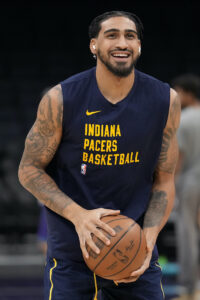The NBA’s rookie scale, which determines how much first-round picks earn during their first four NBA seasons, also dictates how much the qualifying offers will be worth for those players once they’re eligible for restricted free agency after year four. However, the value of those qualifying offers can fluctuate depending on whether or not a player has met the “starter criteria.”
Here’s how the starter criteria works:
A player who is eligible for restricted free agency is considered to have met the starter criteria if he plays at least 2,000 minutes or starts 41 games in the season before he reaches free agency.
A player can also meet the criteria if he averages either of those marks in the two seasons prior to his restricted free agency. For instance, if he makes 30 starts in his contract year after making 52 starts the season before, he would meet the starter criteria.
A player’s ability or inability to meet the starter criteria impacts the value of the qualifying offer he receives as a restricted free agent, as follows:
 A top-14 pick who does not meet the starter criteria will receive a qualifying offer equal to the amount the 15th overall pick would receive if he signed for 120% of the rookie scale.
A top-14 pick who does not meet the starter criteria will receive a qualifying offer equal to the amount the 15th overall pick would receive if he signed for 120% of the rookie scale.
- Note: For the summer of 2024, the value of this QO will be $7,744,600.
- Example: Pacers forward Obi Toppin (2020’s No. 8 overall pick) won’t meet the starter criteria this season. As a result, he’ll be eligible for a QO worth $7,744,600 instead of $9,170,460.
- A player picked between 10th and 30th who meets the criteria will receive a qualifying offer equal to the amount the ninth overall pick would receive if he signed for 120% of the rookie scale.
- Note: For the summer of 2022, the value of this QO will be $8,486,620.
- Example: Hawks forward Saddiq Bey (2018’s No. 19 overall pick) has met the starter criteria this season. As a result, he’ll be eligible for a QO worth $8,486,620 instead of $6,498,258.
- A second-round pick or undrafted player who meets the criteria will receive a qualifying offer equal to the amount the 21st overall pick would receive if he signed for 100% of the rookie scale.
- Note: For the summer of 2022, the value of this QO will be $5,216,324.
- Example: Pistons wing Simone Fontecchio (an undrafted free agent) has met the starter criteria this season. As a result, he’ll be eligible for a QO worth $5,216,324 instead of $3,806,090.
- Note: For the summer of 2022, the value of this QO will be $5,216,324.
- For all other RFAs, the standard criteria determine the amounts of their qualifying offers.
Extending a qualifying offer to a player who is eligible for restricted free agency officially makes that player an RFA, ensuring that his team has the right of first refusal if he signs an offer sheet with another club. It also gives the player the option of signing that one-year QO.
Generally, the value of a restricted free agent’s qualifying offer isn’t hugely important, since very few RFAs accept those offers outright. There are exceptions though.
One notable example occurred in 2020 when Kris Dunn met the starter criteria, which ensured that his qualifying offer would have been worth $7,091,457 instead of $4,642,800. The Bulls opted not to extend that $7MM+ QO, making him an unrestricted free agent, and he ended up signing a two-year, $10MM contract with Atlanta.
If Dunn hadn’t met the starter criteria, Chicago likely would’ve been more comfortable issuing a $4.6MM qualifying offer, which would’ve significantly changed the way Dunn’s free agency played out.
Note: This is a Hoops Rumors Glossary entry. Our glossary posts will explain specific rules relating to trades, free agency, or other aspects of the NBA’s Collective Bargaining Agreement.
Information from Larry Coon’s Salary Cap FAQ was used in the creation of this post. Earlier versions of this post were published in previous years.